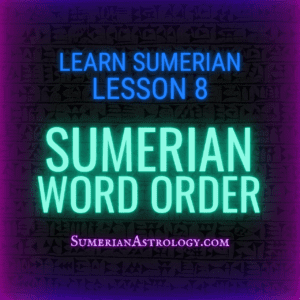Lesson 8
Sumerian Word Order
In this lesson, you’ll get familiar with Sumerian word order, also known as Sumerian syntax. You’ll also be introduced to the Sumerian nominal chain and verbal chain, which are major parts of learning Sumerian!
Need a Refresher on Case Markers?
Helpful Terms
Here is a list of helpful terms you’ll encounter in this lesson. You can see the full Glossary of Terms here.
- syntax: the order of words in a sentence.
- agent: the noun in the sentence that performs the action.
- infix: a particle within the verbal chain that provides additional meaning about the sentence.
- patient: the noun in the sentence that experiences the action.
- nominal chain: a string of words and suffixes which provides all necessary information about the nouns in a sentence.
- verbal chain: a string of prefixes, infixes, and suffixes attached to a verb to provide additional information about the action.
Vocabulary--Full List
You should already have these Sumerian words memorized, but take a time to look them over, as additional definitions are included as the lessons progress!
- an 𒀭 n., heaven; high. part., inf., he/he (erg.)
- ba 𒁀 n., allotment, portion, wages. v., to give; pay; divide; distribute; allot. part., inf., it/they/them (ind. obj.)
- dù 𒆕 v., to beget; bear (a child); be born; build, create, fashion, make; transform, change.
- e 𒂊 v., to speak, say; do; water. part., [performed] by (the agent); in, at, beside.
- é 𒂍n., house, temple.
- lugal 𒈗 n., king; owner, master, lord.

Subject-Object-Verb (SOV)
Just as they do in English, words in Sumerian sentences follow a particular pattern, or syntax.
In English, the usual order of words is Subject-Verb-Object (SVO), as in:
- The king built the house.
- The king(sub.) built(v.) the house(obj.)
However, in Sumerian, the normal word order is Subject-Object-Verb (SOV).
- Sumerian: lugal-e é ba-an-dù
- Cuneiform: 𒈗𒂊𒂍𒁀𒀭𒆕
- English: The king built the temple.
- Breakdown:
- king(sub.)
- temple(obj.)
- it-he-built(v.)
Nominal and Verbal Chains
The above sentence, lugal-e é ba-an-dù 𒈗𒂊𒂍𒁀𒀭𒆕, has two parts:
- a nominal chain: lugal-e é 𒈗𒂊𒂍 king-by house/temple
- which provides all the information we need about the nouns
- a verbal chain: ba-an-dù 𒁀𒀭𒆕 it-he-built
- which provides all the information we need about the verb
In the next few lessons, you’ll often see me separate the nominal and verbal chains with a ‘|’ to help you get used to identifying them, as in:
- lugal-e é | ba-an-dù
- 𒈗𒂊𒂍 | 𒁀𒀭𒆕
NOTE: This ‘|’ is not the same as a slash you’ll sometimes see separating words, lines, and concepts on a cuneiform tablet. I’m simply using this divider to break up elements and make learning Sumerian easier.
Your Sumerian Language Journey Continues!
Awesome! You are well on your way to mastering the Sumerian language! In the next lesson, you’ll learn about the Sumerian Nominal chain, so be sure to subscribe to my substack to get notified of all new posts!


